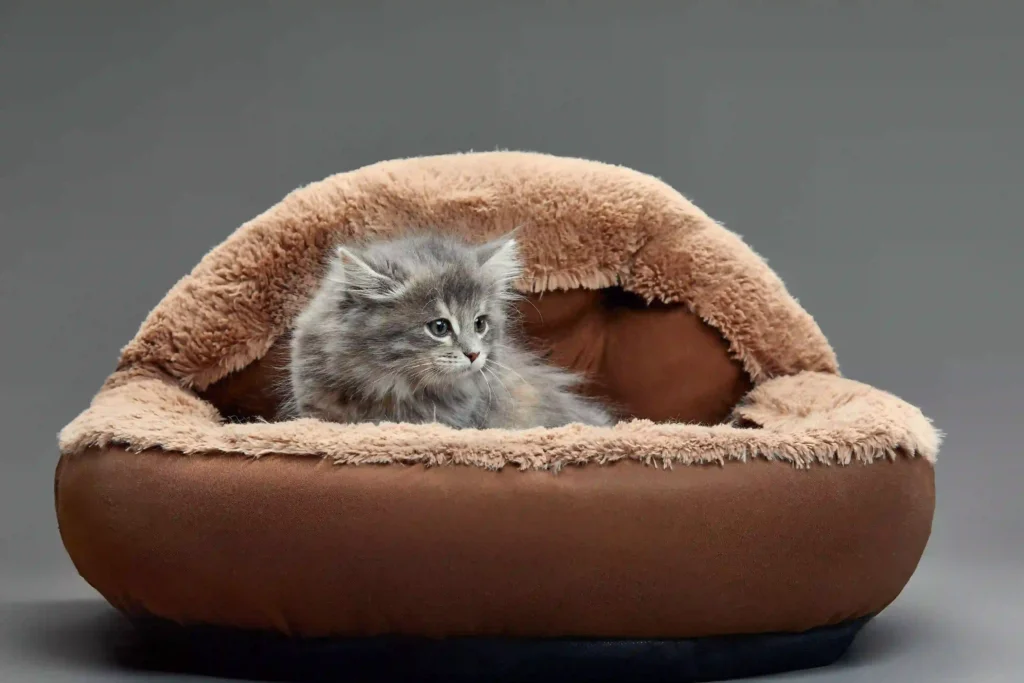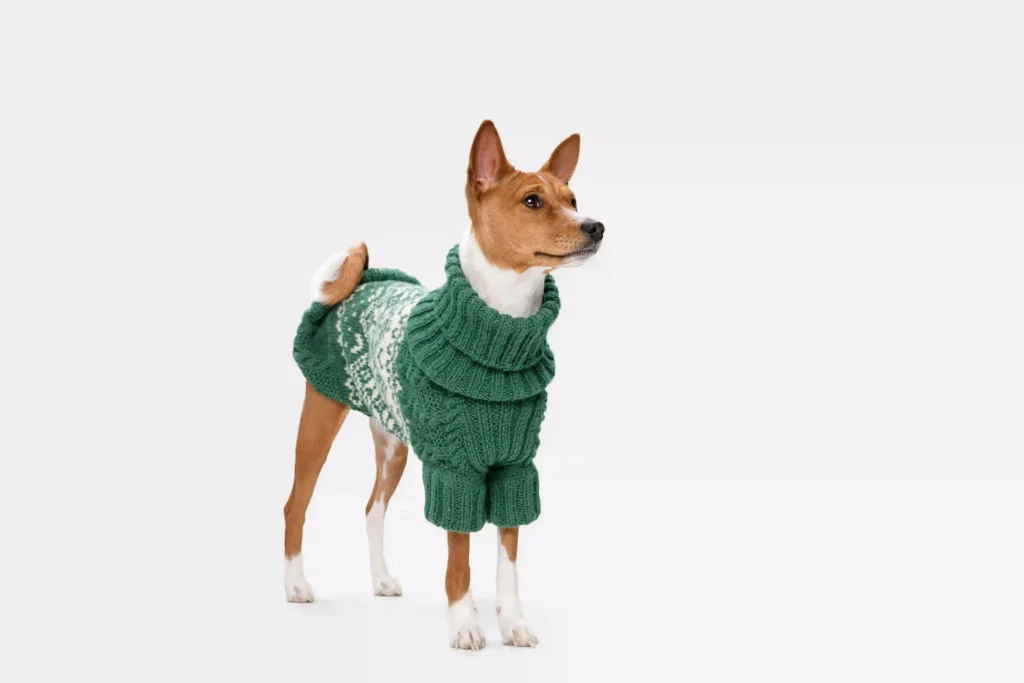Winter tips for dogs and cats: As the winter weather rolls in, our furry pals require additional attention to be warm and comfy. Bitter winds and cold temperatures may hurt pets just as much as people, so pet owners must be vigilant throughout the winter. The blog article includes eight critical tips for providing pet owners with the knowledge and behaviors needed to protect the safety and well-being of their beloved animals. From identifying signals of discomfort to addressing shifting nutritional demands, this piece offers a thorough guide to creating a safe refuge for our four-legged partners throughout the winter months, developing a connection that can withstand the cold while flourishing in warmth and care.
Provide Adequate Shelter
Providing a warm and dry shelter for your dogs is the first step towards ensuring their comfort during the winter. It is impossible to exaggerate the value of having a warm place to sleep, particularly when the weather becomes chilly.

Make sure your pets have a cozy haven within your house by positioning their beds or crates away from drafts to protect them from the cold. Upgrade their resting space with more blankets or a heated pet bed—a small but meaningful addition that can go a long way toward keeping them cozy and happy on the coldest evenings. If your pet spends a lot of time outside, you might want to consider getting them an insulated and weatherproof doghouse.
It’s also critical to make sure your pets’ shelters are maintained and inspected regularly to ensure their effectiveness during the winter. Look for any drafts or leaks that could affect how warm their sleeping space is. In addition to putting your pets’ physical comfort first, you’re also promoting their general well-being and enjoyment during the winter months by giving them access to a draft-free, well-insulated room.
To ensure that your pets’ shelters remain effective throughout the winter, it’s also imperative that they be regularly cleaned and examined. Inspect for any leaks or drafts that can impact the temperature of their sleeping area. Giving your pets access to a draft-free, well-insulated room throughout the winter months not only prioritizes their physical comfort but also their overall well-being and happiness.
Dress Them Up
Giving your pets a little extra insulation in the dead of winter can make a big difference in how comfortable they are. Like their human counterparts, dogs and cats can benefit from the extra warmth of comfortable sweaters or jackets, especially if they have short fur.

These articles of clothing serve as a barrier between them and the bitter cold, keeping their body temperature stable and protecting them from the weather. Make sure your pet’s clothing fits properly and completely encloses their body to prevent cold drafts. This fulfills a practical need and can also be a fun way to highlight your pet’s own flair with a variety of stylish and useful winter clothing.
Purchasing winter gear for your pets is very important when engaging in outside activities such as walks or snow adventures. These clothes’ insulation keeps them warmer for longer periods and lessens the discomfort that comes with being outside in the cold. Beyond just being practical, spicing up your dogs for the winter can be a fun and sociable activity that fosters moments of care and attention exchange. When you go on outdoor adventures with your pets, seeing them dressed warmly lends an additional touch of elegance while guaranteeing their welfare is given first consideration.
Keep in mind that every pet is different and that they may or may not tolerate the cold, so pay attention to how they react and modify your wardrobe accordingly. Not only will these winter wardrobe needs improve your pets’ physical health, but they will also give their winter routine a dash of elegance and happiness.
Limit Outdoor Time
It’s tempting to let our canines enjoy the seasonal charm as the snow-covered winter landscape gradually takes shape. But it’s important to find a middle ground between keeping kids warm and enjoying themselves. Even while dogs enjoy playing in the snow, it’s important to be aware of the possible hazards connected to extended exposure to cold temperatures. Shorten the amount of time they spend outside so they can enjoy the benefits of winter without endangering their health. This precaution becomes especially important in cold weather because pets might suffer from hypothermia or frostbite, which emphasizes the significance of short and sweet outdoor excursions. Important factors to consider when restricting outdoor time:
- Keep an eye on the weather, paying particular attention to wind chill, and modify outdoor activities as necessary.
- Notice symptoms of distress in your pet, such as shaking or running for cover, act quickly to soothe them
- Provide your pet with a warm and inviting indoor area to retreat to following outdoor adventures by furnishing it with comfy blankets and bedding.
- For information on how long is appropriate for outdoor activities based on your pet’s breed, age, and overall health, speak with your veterinarian.
Additionally, be sure to give your pet a thorough drying off after every outside adventure. They may become damp from the snow and cold, which raises the possibility that they will become chilled. Take extra care to check that their paws are free of any snow or ice adhering to their fur. Consider using pet-friendly booties to shield your feet from the hard impact of icy surfaces in addition to drying them off. Your pets will find it more comfortable to make the transition from the cold outside to the warmth of your home thanks to these booties, which also shield their paws and add an extra layer of insulation.
Maintain a Healthy Diet
As winter approaches, it’s critical to be aware of our pets’ nutritional requirements because their diet may need to be modified due to the lower temperatures.

A visit to the veterinarian becomes very beneficial at this point since they may offer customized guidance on how to adjust your pet’s food consumption to guarantee they get the energy they need to stay warm. Certain pets might need to consume a little more calories in the winter, based on things like breed, age, and degree of activity. Proactively attending to their nutritional needs not only promotes physical health but also provides them with the energy they require to flourish throughout cold weather.
Apart from modifying their diet, it’s crucial to guarantee that your pets always have access to clean, warm water. Even in the winter, staying hydrated is vital to their general health. Because interior heating systems and the dry winter air can cause dehydration, it is important to watch how much water they are consuming. A well-hydrated pet not only supports healthy digestion and general well-being but is also more resilient to the obstacles presented by the cold. By incorporating these nutritional considerations into your routine for winter care, you can help your pets not only survive but also look forward to the winter months, knowing that they are well-fed and prepared to appreciate everything that this season has to offer.
For even more comprehensive wintertime care for your pets, think about adding extra nutrition using supplements that your veterinarian has prescribed. These supplements can help with certain health issues associated with winter, such as dry skin and stiff joints. A comprehensive nutrition plan supported by expert guidance takes a proactive approach to protecting your dogs’ health during the winter and enables them to thrive despite the challenges of the changing seasons.
See our blog on “Best Dog Food: How to Choose the Right Food for Your Pet“
Groom Regularly
A vital component of guaranteeing your pet’s happiness and well-being is taking care of their coat, particularly when winter approaches and presents its own set of difficulties. A well-maintained coat is essential for offering efficient protection from the chilly air.

Brushing your pet regularly is an easy yet effective way to keep their fur healthy. By eliminating loose fur, this procedure helps keep it from matting and creating bothersome tangles. Regularly taking care of their coat helps them feel more comfortable physically and strengthens your relationship with them by grooming them in a kind and loving manner.
You must, however, maintain equilibrium in your grooming regimen. Brushing your pet regularly is good, but giving them too many baths in the winter might be harmful to their skin. Too many baths could deplete their coat of vital oils, causing dry skin and possibly discomfort. For advice on a grooming regimen that is suitable for your pet’s breed, coat type, and specific needs, speak with your veterinarian. This methodical approach guarantees that your pet’s coat continues to provide warmth and protection, strengthening their ability to withstand the harsh winter weather and improving the condition of their skin overall.
During grooming procedures, check your pet’s feet, ears, and tail in addition to brushing and bathing issues. Ear infections and dry paw pads are two problems that might be exacerbated by the winter. By taking care of these difficulties early on in your pet’s grooming regimen, you can help avoid any health problems associated with the winter and give your pet the best possible start to the season with not just a well-groomed coat but also general comfort and vigor.
Create a Cozy Indoor Space
Making your house a cozy and welcoming retreat for your dogs is a considerate way to make sure they are comfortable throughout the winter.

To provide your pets with warm, pleasant spaces to rest and recuperate, think about arranging blankets or pet beds in locations that are shielded from drafts. These comfortable areas act as a barrier against the cold, providing a haven that they can call their own inside the house. Additionally, by making the effort to locate and fix any drafty locations, you can make sure that your pets can enjoy these areas without being exposed to the chilly winter air currents.
Apart from picking comfortable nooks, consider placing these rest areas next to a source of warmth. Creating a warm refuge for your pets—whether it’s a fireplace, radiator, or specially heated pet pad—improves their capacity to control their body temperature and promotes their wellbeing. Given their affinity for warmth, cats especially value discovering cozy places to curl up. You may create an environment that not only satisfies their bodily requirements but also fosters a sense of security and contentment by giving in to their natural impulses and preferences.
Moreover, you can customize your pet’s indoor environment to their tastes by paying attention to their behavior and preferences. During the winter months, observe where they tend to congregate naturally and provide extra warmth and comfort there. With the warmth and attention of your home during the winter, your dogs will not only survive but also genuinely enjoy the season thanks to this customized approach. Making your house feel warm and inviting becomes a vital component of their winter experience, establishing a link between their health and the welcoming areas you’ve carefully set up for them.
Watch for Signs of Discomfort
Being watchful is crucial when it comes to protecting your pets in the cold because they might not always express their discomfort in an obvious way.

Make sure you keep a watchful and close eye on your animal friends, particularly when they are outside or in colder climates. Shivering, lethargy, and a propensity to seek out warm locations are obvious indications that your pet may be feeling chilly, but there are other signs as well. Lethargy could indicate that your pet’s energy is being depleted by the cold while shivering is an obvious indication that they are trying to generate body heat.
It’s important to speak with your veterinarian right away if you see any strange behavior or pain indicators. The right course of action and the underlying reason for your pet’s unhappiness can be determined with the assistance of a professional. As winter temperatures can aggravate some health conditions or put particular breeds at risk, prompt veterinary consultation is crucial to preventive pet care. By responding quickly to symptoms of discomfort, you not only put your pet’s health first but also save possible health problems from getting worse.
It’s also critical to know how well your pet tolerates the cold on an individual basis. Their tolerance of colder temperatures can be influenced by variables like age, breed, and general health. By basing your strategy on these variables, you can make sure that your pet’s treatment is individualized and tailored to meet their unique needs. You can traverse the winter months with confidence and make sure your dogs are happy and healthy despite the challenges of the cold by establishing a pattern of routine observation and prompt response to signals of distress.
Regular Vet Check-ups
Regular veterinary checkups are essential to provide appropriate pet care because the chilly weather has the potential to worsen underlying health conditions in pets. This is especially true as winter approaches.

Certain illnesses, including arthritis or respiratory issues, may be exacerbated by cold temperatures; however, a thorough examination enables your veterinarian to evaluate your pet’s general health and well-being. It’s especially important to make sure your pets have received all of their recommended vaccines throughout the winter, when certain illnesses may provide a higher risk. Vaccinations promote a better environment for your pet and the community by protecting them from infectious diseases and halting their spread.
In addition to immunizations, these examinations offer a chance to talk about any particular worries you may have regarding the health of your pet over the winter. Based on your pet’s unique needs, your veterinarian can provide customized advice on everything from nutrition adjustments to behavioral changes and prevention of typical winter diseases. This proactive approach not only promotes their mental and emotional well but also their physical health, making the winter months peaceful and comfortable for pets and their owners.
You and your veterinarian can work together to provide your pets with care by encouraging ongoing, honest communication. Routine examinations turn into a proactive approach to dealing with possible problems before they worsen, providing peace of mind and empowering you to face the winter’s challenges head-on. Setting aside time for routine veterinary examinations as conscientious pet owners is an investment in the long-term well-being and contentment of your cherished friends, laying the groundwork for a prosperous and satisfying winter.
See our blog on “Unlocking Quality Care: Pet Clinic Features Every Pet Owner Should Consider” and also have a look at “Basic Health & Care Tips to Keep Your Cat Healthy“
Winter Tips for Dogs and Cats: Conclusion
You can make sure that your cats and dogs are warm and cozy throughout the winter by paying attention to these pointers. Keep in mind that every pet is different, and their requirements could change, so pay attention to their particular tastes and habits. You and your furry friends may enjoy a warm and comfortable winter together with a little additional care.


